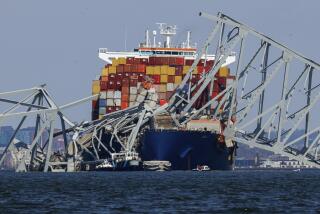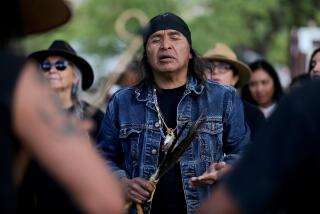A race to save trapped miners
Grim-faced rescue workers covered with coal dust drilled halfway toward six miners trapped 1,500 feet underground Wednesday, as family members continued their agonizing wait for any survivors of Monday’s cave-in.
“I have full faith they are in there alive and breathing,” said mine safety supervisor Bodee Allred, his voice trembling. His cousin is one of the trapped miners.
The Crandall Canyon Mine collapsed early Monday, and persistent seismic rumblings stalled rescue efforts until Wednesday morning. Officials said they drilled a 2-inch-wide hole 875 feet deep and believe it will pierce the casing of the cavity that holds the miners, enabling them to find out whether the men are alive. They were also drilling a second, 8-inch-wide hole to supply them with air, food and water.
Sonic monitoring equipment has picked up no sign of tapping to indicate the workers are alive. The men cannot be extracted for a week at the earliest, and if the holes are drilled at an incorrect angle, they could hit solid rock rather than the space where the miners are trapped, said Robert E. Murray, chief executive of Murray Energy Corp., which owns the mine.
Murray said the holes may reach the miners in 48 hours or less. He remained optimistic that the workers would survive if the holes reached them.
“They can survive underground indefinitely . . . indefinitely,” he said during an evening news conference. “We can provide everything they need . . . including a toothbrush and a comb.”
Residents of this tightly knit region distributed fliers urging residents to attend upcoming vigils for the trapped miners. In an area where an estimated 90% of all jobs are in the energy industry, most residents know the affected families and can picture themselves or their loved ones in the same situation.
“I don’t think there is a family that isn’t impacted in some way,” Huntington Mayor Hilary Gordon said.
Some family members began to voice frustration with the slow rescue operation. The company has rented the local junior high school and secluded relatives there. Murray has advised them not to speak to reporters, and sheriff’s deputies are guarding the building.
Maria Buenrostro, whose brother Manuel Sanchez is one of the trapped miners, told the Associated Press that Murray got angry with relatives’ questions and walked out of a meeting. She added that there was no interpreter provided for three Spanish-speaking families.
“We want the truth; that’s all we want,” said Buenrostro. “If there’s nothing that they can do about it, you know, just tell us so we know what to expect when they bring them out.”
Murray took two relatives down into the mine for an afternoon tour and pledged to distribute bilingual information. “The families are doing incredibly well, given the circumstances,” said Rob Moore, a vice president with Murray Energy. Though officials still refuse to release the names of the trapped miners, friends and families began to confirm some identities Wednesday. In addition to Sanchez, relatives confirmed that the group includes Don Erickson and Kerry Allred.
Allred’s relatives are typical of the generations of mining families that have populated this high-desert area for a century. Lee Cratsenburg, one of Allred’s many cousins and a former mine worker herself, said relatives worked in local mines as far back as 1912. Relatives say Allred’s son, a mining veteran, accompanied Murray on a tour of the mine Wednesday, while another cousin, Bodee, supervised the rescue work above.
Cratsenburg said she believed her cousin’s three decades of mining experience had prepared him to survive. “I’m sure he’s going to be OK,” she said. “He’s been in enough mines.”
“Kerry’s the roughest one out of the whole bunch, because he’s getting close to retirement,” said family friend Paul Simmons of the father of three.
Simmons said that Allred’s children were having a difficult time with the uncertainty over whether their father was alive. “It’s happened before. Guys have made it,” he said. “But it’s so few and so rare.”
Utah is the 12th-largest coal-producing state in the nation, and all 13 of its coal mines are located within the broad, sagebrush-studded expanses of Emery and Carbon counties in central Utah where Crandall is located. Unlike mines in the eastern U.S., coal in the West is lodged deep underground, which is more expensive to extract. David A. Litvin, president of the Utah Mining Assn., said the state’s coal was “the deepest in the U.S., going down as much as 3,000 feet.”
Public records show that workers at the Crandall Canyon Mine were performing “retreat mining,” a risky technique that involves leaving columns of coal to support the roof while veins are tapped, then pulling down those columns and allowing the roof to collapse as miners escape. It’s unclear whether that was being done Monday morning, when seismologists registered a 3.9 tremor near the mine that they say was probably the collapse of the mine. Murray has insisted the event was a separate quake that triggered the cave-in.
The miners were 1,500 feet below ground when trapped. In contrast, the 12 miners who died in an explosion in Sago, W.Va., last year were 260 feet down.
It was unclear what resources were available to keep the miners alive until the relief holes are drilled. The mine’s emergency response plan, released by a congressional oversight committee, shows that water and food supplies appear to be spread out over large distances underground. The plan calls for caches of food and water to last each worker for four days, but federal mining regulators gave the company until Monday to place emergency air supplies underground at 2,000-foot intervals.
Residents know the risks of mine work -- 27 miners died in a fire in another mine in 1984, and a group of local miners traveled to Sago last year for the memorial for the miners lost there. But generations continue to delve into the ground partly because new workers can make as much as $100,000 annually with benefits.
“They’ve lived with it their whole lives,” Emery County Commissioner Drew Sitterud said of the risk. “Coal is our lifeblood.”
Residents gathered on the rodeo grounds across from the junior high school Wednesday evening for a candlelight vigil. Retired miner Henry Smith, 67, said he was proof that workers could make it out of seemingly inescapable collapses. Years ago, he was trapped for 2 1/2 hours in an underground cave-in, and woke up in a hospital bed. “All I can do is hope for the best,” Smith said. “All I can do is pray.”
Some local miners said they were undeterred by the collapse. Luis Hernandez, 44, has worked with all six trapped miners in his career. He works at another mine that will begin retreat mining next week, and is looking forward to it. “I like it; it’s exciting to me,” he said.
To drill the relief holes, emergency workers had to clear 8,000 feet of roads through rugged mountains. Rescuers cautiously descended into the tunnels to clear debris and improve ventilation units, preparing to dig the miners out once they find out whether they’re alive.
Murray on Wednesday led reporters on a tour of the rescue operations outside the mine. He paused by a giant mound of coconut-sized chunks of coal that towered next to the entrance. “This is the last coal those miners removed before the collapse,” he said. “Everything on top was their work.”
--
nicholas.riccardi@latimes.com
Photographer Spencer Weiner in Huntington and Times staff writer Janet Wilson in Los Angeles contributed to this report. Powers reported from Huntington and Riccardi from Denver.
More to Read
Start your day right
Sign up for Essential California for news, features and recommendations from the L.A. Times and beyond in your inbox six days a week.
You may occasionally receive promotional content from the Los Angeles Times.






